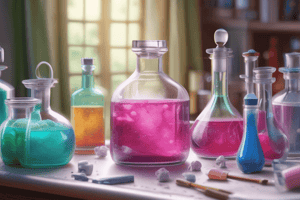Podcast
Questions and Answers
What is the primary function of an emulsifier in a cosmetic emulsion?
What is the primary function of an emulsifier in a cosmetic emulsion?
- To create a smooth, even texture on the skin
- To reduce the interfacial tension between the liquids (correct)
- To thicken the emulsion
- To deliver moisturizing ingredients to the skin
What type of emulsion is characterized by oil droplets dispersed in water?
What type of emulsion is characterized by oil droplets dispersed in water?
- Water-in-Oil (W/O) Emulsion
- Microemulsion
- Oil-in-Water (O/W) Emulsion (correct)
- Multiple Emulsion
Which of the following factors can cause an emulsion to break down or undergo phase inversion?
Which of the following factors can cause an emulsion to break down or undergo phase inversion?
- Changes in pH
- Changes in temperature
- Changes in concentration
- All of the above (correct)
What is the primary role of thickeners in emulsions?
What is the primary role of thickeners in emulsions?
Which type of emulsifier is commonly used to reduce surface tension and allow oil and water to mix?
Which type of emulsifier is commonly used to reduce surface tension and allow oil and water to mix?
What is the primary benefit of emulsions in terms of skin feel?
What is the primary benefit of emulsions in terms of skin feel?
What is the primary purpose of adding preservatives to cosmetics?
What is the primary purpose of adding preservatives to cosmetics?
Which type of preservative is commonly used in personal care products?
Which type of preservative is commonly used in personal care products?
What is the primary mechanism of action of formaldehyde-releasers?
What is the primary mechanism of action of formaldehyde-releasers?
Which of the following preservatives is often used in natural and organic products?
Which of the following preservatives is often used in natural and organic products?
What is the primary characteristic of natural preservatives?
What is the primary characteristic of natural preservatives?
Flashcards are hidden until you start studying
Study Notes
Emulsions in Cosmetics
Definition
- A mixture of two or more liquids that don't normally mix (e.g., oil and water)
- Emulsions are stabilized by an emulsifier, a surface-active agent that reduces the interfacial tension between the liquids
Types of Emulsions
- Oil-in-Water (O/W) Emulsions: oil droplets dispersed in water (e.g., moisturizing creams, lotions)
- Water-in-Oil (W/O) Emulsions: water droplets dispersed in oil (e.g., lip balms, sunscreen sticks)
- Multiple Emulsions: emulsions within emulsions (e.g., oil-in-water-in-oil emulsions)
Emulsifiers in Cosmetics
- Surfactants: reduce surface tension, allowing oil and water to mix (e.g., sodium lauryl sulfate, cetyl alcohol)
- Emollients: help stabilize emulsions, improve skin feel (e.g., glycerin, lanolin)
- Thickeners: increase viscosity, enhance texture (e.g., carrageenan, xanthan gum)
Factors Affecting Emulsion Stability
- pH: affects emulsifier performance and stability
- Temperature: changes can cause emulsion breakdown or phase inversion
- Concentration: emulsifier concentration affects emulsion stability and texture
Importance in Cosmetics
- Moisturizing: emulsions help deliver moisturizing ingredients to the skin
- Skin Feel: emulsions can create a smooth, even texture on the skin
- Product Stability: emulsions help maintain product consistency and shelf life
Studying That Suits You
Use AI to generate personalized quizzes and flashcards to suit your learning preferences.




